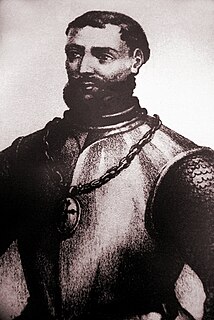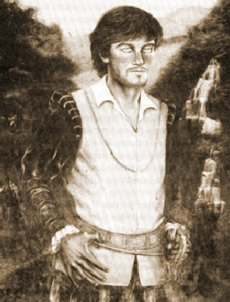 W
WHernán Cortés de Monroy y Pizarro Altamirano, 1st Marquess of the Valley of Oaxaca was a Spanish Conquistador who led an expedition that caused the fall of the Aztec Empire and brought large portions of what is now mainland Mexico under the rule of the King of Castile in the early 16th century. Cortés was part of the generation of Spanish explorers and conquistadors who began the first phase of the Spanish colonization of the Americas.
 W
WAlbert S. Evans was an American explorer and writer. Prior to 1856, he lived in Pittsburgh, Pennsylvania and worked as a broker. He lived in Chicago and worked for many years at the Daily Journal. Evans arrived in San Francisco in 1861, began working as a journalist for the Morning Call and served on the staff of the Governor of California during the Civil War.
 W
WDionisio Alcalá Galiano was a Spanish naval officer, cartographer, and explorer. He mapped various coastlines in Europe and the Americas with unprecedented accuracy using new technology such as chronometers. He commanded an expedition that explored and mapped the Strait of Juan de Fuca and the Strait of Georgia, and made the first European circumnavigation of Vancouver Island. He reached the rank of brigadier and died during the Battle of Trafalgar.
 W
WFrancisco Hermenegildo Tomás Garcés, O.F.M., was a Spanish Franciscan friar who served as a missionary and explorer in the colonial Viceroyalty of New Spain. He explored much of the southwestern region of North America, including present day Sonora and Baja California in Mexico, and the U.S. states of Arizona and California. He was killed along with his companion friars during an uprising by the Native American population, and they have been declared martyrs for the faith by the Catholic Church. The cause for his canonization was opened by the Church.
 W
WJuan de Grijalva was a Spanish conquistador, and a relative of Diego Velázquez. He went to Hispaniola in 1508 and to Cuba in 1511. He was one of the early explorers of the Mexican coastline.
 W
WFrancisco Hernández de Córdoba was a Spanish conquistador, known to history mainly for the ill-fated expedition he led in 1517, in the course of which the first European accounts of the Yucatán Peninsula were compiled.
 W
WFrancisco de Ibarra was a Spanish-Basque explorer, founder of the city of Durango, and governor of the Spanish province of Nueva Vizcaya, in present-day Durango and Chihuahua.
 W
WFerdinand Konščak was a Croatian Jesuit missionary, explorer and cartographer.
 W
WAlejandro Malaspina was a Tuscan explorer who spent most of his life as a Spanish naval officer. Under a Spanish royal commission, he undertook a voyage around the world from 1786 to 1788, then, from 1789 to 1794, a scientific expedition throughout the Pacific Ocean, exploring and mapping much of the west coast of the Americas from Cape Horn to the Gulf of Alaska, crossing to Guam and the Philippines, and stopping in New Zealand, Australia, and Tonga.
 W
WFrancisco de Montejo y Álvarez was a Spanish conquistador in Mexico and Central America.
 W
WPánfilo de Narváez was a Spanish conquistador and soldier in the Americas. Born in Spain, he first embarked to Jamaica in 1510 as a soldier. He came to participate in the conquest of Cuba and led an expedition to Camagüey escorting Bartolomé de las Casas.
 W
WÁlvar Núñez Cabeza de Vaca was a Spanish explorer of the New World, and one of four survivors of the 1527 Narváez expedition. During eight years of traveling across what is now the US Southwest, he became a trader and faith healer to various Native American tribes before reconnecting with Spanish civilization in Mexico in 1536. After returning to Spain in 1537, he wrote an account, first published in 1542 as La relación y comentarios, which in later editions was retitled Naufragios y comentarios. Cabeza de Vaca is sometimes considered a proto-anthropologist for his detailed accounts of the many tribes of Native Americans that he encountered.
 W
WFrancisco de Ulloa was a Spanish explorer who explored the west coast of present-day Mexico under the commission of Hernán Cortés. The reports of his expeditions along the Baja California Peninsula are credited with being influential in the perpetuation of the 17th century cartographic misconception of the existence of the Island of California.
 W
WFrancisco Vázquez de Coronado y Luján was a Spanish conquistador and explorer who led a large expedition from what is now Mexico to present-day Kansas through parts of the southwestern United States between 1540 and 1542. Vázquez de Coronado had hoped to reach the Cities of Cíbola, often referred to now as the mythical Seven Cities of Gold, which is a term not invented until American gold-rush days in the 1800s. His expedition marked the first European sightings of the Grand Canyon and the Colorado River, among other landmarks. His name is often Anglicized as "Vasquez de Coronado" or just "Coronado".
 W
WÁngel de Villafañe was a Spanish conquistador of Florida, Mexico, and Guatemala, and was an explorer, expedition leader, and ship captain, who worked with many 16th-century settlements and shipwrecks along the Gulf of Mexico.